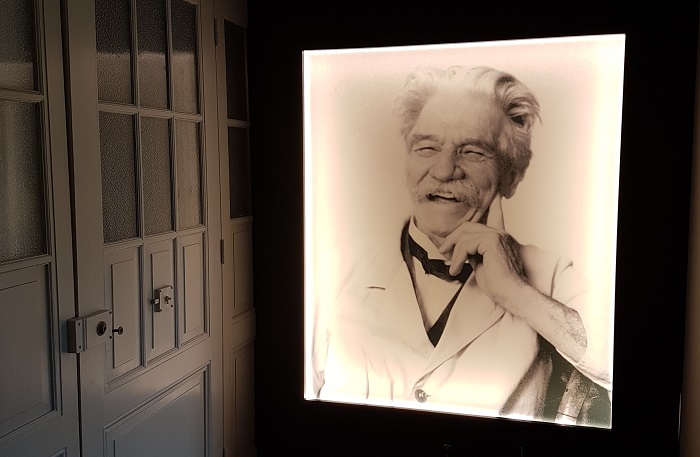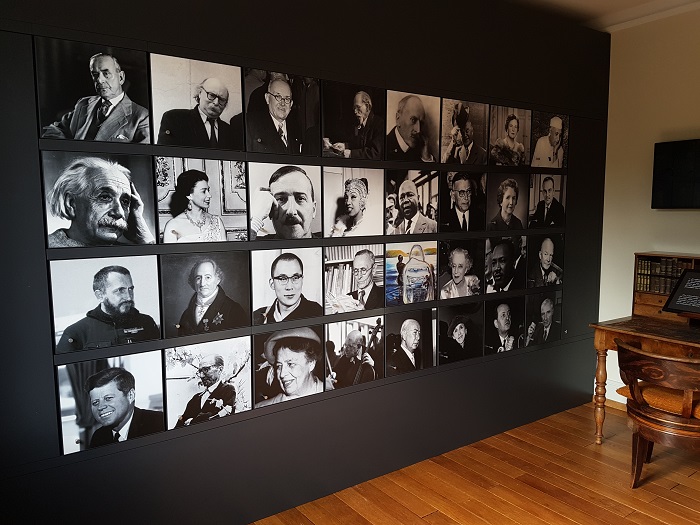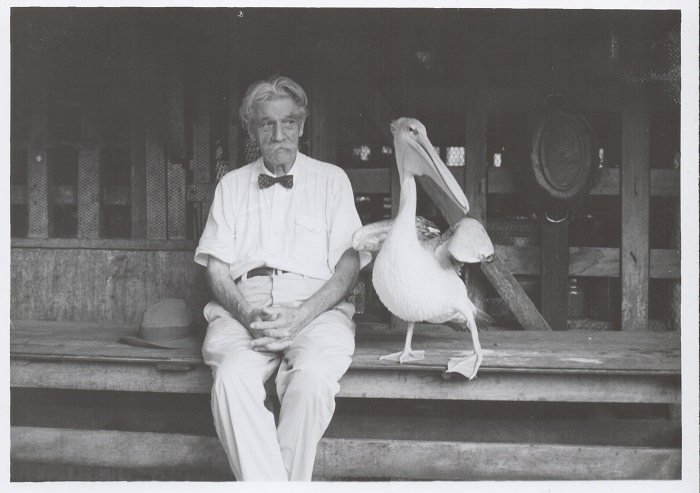ALBERT SCHWEITZER WAS A THEOLOGIAN AND MINISTER, DOCTOR AND MUSICIAN, BUT ALSO A LITTLE KNOWN NOBEL PRIZE WINNER FROM ALSACE. HIS HOUSE IN GUNSBACH, NEAR COLMAR, IS THE HERITAGE OF A VISIONARY HUMANITARIAN.
He is one of the rare Frenchman to have been awarded a Nobel Prize, and yet he remains largely unknown. Jenny Litzelmann, the director of the Maison Albert Schweitzer, in Gunsbach, near Colmar, regrets that at most Albert Schweitzer was known as the good white doctor in Lambaréné, in Gabon. “He was forgotten like many other Alsace artists and philosophers after 1918 when they became French...” A double culture that ended up bothering certain people from Alsace.

When Albert Schweitzer was pushed to say which country he considered to be his, having been born German and becoming French in 1918, he would always answer: “I am a man from Gunsbach and a citizen of the world”.
The man from Alsace was born in Kaysersberg in 1875, and grew up in Gunsbach with a minister for a father. He was a visionary philosopher, and gave details of his concept of “boundless responsibility towards all living beings” in his book La civilisation et l'éthique (Civilisation and Moral Codes). Albert Schweitzer was himself a minister, philosopher and theologian, and also a doctor and organist. Incidentally it is also partly thanks to cachets and his organ concerts that he financed at his hospital in Gabon.
CIVILISATION IN DECLINE
The commitment as a “man serving men” garnered him the Goethe prize from the city of Frankfurt in 1928 (two years later the recipient was Sigmund Freud), and thanks to the money he received from it he built his house in Gunsbach, which was his pied-à-terre in Europe when he came back from Lambaréné. He set up his albeit Spartan office in the two-storey house surrounded by nature, and that of his associate for collecting funds for his hospital in Gabon.

It still belongs to the Association internationale pour l’œuvre du docteur Albert Schweitzer, which the doctor founded. Jenny Litzelmann explained, “He thought that everyone could have their own Lambaréné: that everyone could find a way in their life to make a commitment to other people, however they could, even if was just for one or two hours a week”.
Spreading boundless responsibility towards all living beings was the centre of Albert Schweitzer’s action. From 1915, he understood that civilisation was in decline, that a universal moral code was needed that respects all living beings in order to create a world civilisation. And from the end of the 19th century, he observed the rise of nationalism, and technical advances that were too fast and alienating.
CLOSE TO EINSTEIN AND THE DALAI LAMA
A life of complete commitment to serving living beings is revealed in this museum-house. His overall medical work is presented on the lower level of the house, while the ground floor looks at his life, from when he was born to his Nobel prize. The portraits of leading figures he was close to saying nothing but are vibrant, lined up in black and white on a very graphic wall: Einstein, Josephine Baker, the pastor Martin Luther King, Abbé Pierre, the Dalai Lama...
The intellectual work of Albert Schweitzer is laid out in the recent harmonious contemporary extension, a great part of which is underground, designed by the architect Michel Spitz from Colmar. It houses a reception on the garden level, a room for educational workshops, a space for temporary exhibitions as well as the collection of African objects that were kept at Gunsbach town hall until then.

YOUNG PEOPLE ARE RIGHT
The permanent exhibition devoted to boundless responsibility towards all living beings has been designed as a kind of initiatory path, gradually widening out as it reveals itself, going from self-respect to that of all people. It is a museographic challenge that relies on parts from Schweitzer’s book.
The visitor’s image is reflected infinitely in a rectangular space made up of mirrors. And this quote can be read: “Juvenile idealism is right”. “Albert Schweitzer said that the main thing was to keep your ideals. Becoming a mature man is to lose your moral convictions, resign yourself”, the director indicates.
An accomplished person must support the idealism of young people, “a treasure that must not be lost for anything in the world”, they must keep their enthusiasm against the world’s adversity and cynicism.
STUDYING MEDICINE AT 30 YEARS OLD
“He was no doubt faced with this problem when he decided to start studying medicine, because he was very disappointed that his theologian friends did not understand him. For him, it was in the field that Jesus made a commitment to others”. Albert Schweitzer therefore chose to put his robes of minister, writer and academic aside to act in a more tangible manner. “This undertaking was not just a question of religion, it was his human moral duty”.

The approach had been well thought out: at 21 years old, the young Schweitzer decided he would perfect his knowledge of music, theology and philosophy until he was 30 years old. And then he would devote his life to others. But without yet knowing how. Albert Schweitzer explored. He tried founding an orphanage, then a shelter for young former convicts. In vain.
Until a small advertisement for a doctor’s position in the Congo was a revelation for him. “That was his path: to be in direct contact with people suffering in their body. He therefore started studying medicine. And eight years later, he arrived in the Congo”.
FREE HUMANS FROM NEED
Being out in the field no doubt nourished his thoughts even more, which spread out over thirty or so years. In La civilisation et l'éthique, Albert Schweitzer sees living around an economy as an obstacle to civilisation, by stifling all spiritual life. He condemns overwork, particularly to task specialisation and budding Taylorism, which prevents people from thinking.
In this critique of the 20th century, he confirms that “society has the duty to provide what is needed to free the individual from the need to survive”.
In addition he outlines the fact that humans have acquired the ability to destroy themselves. And he already highlights the media’s hunt for sensational headlines and the emergence of the entertainment society. For Albert Schweitzer, the individual has the duty to protect themselves and to resist to keep “faith in truth and humanity”.
When awarded his Nobel prize in 1952, it was in the Peace category, for this tireless commitment to his fellow beings.
Lucie Michel
Maison Albert Schweitzer, in Gunsbach (8 rue de Munster).
Open from Tuesday to Sunday from 10am to 12pm and from 2pm to 5pm (+ Sundays from June to September).
Prices: from €3 to €7 (free for the under 5s).
Find out more on www.schweitzer.org
Maison Albert Schweitzer is part of the Touristic Sites of Alsace